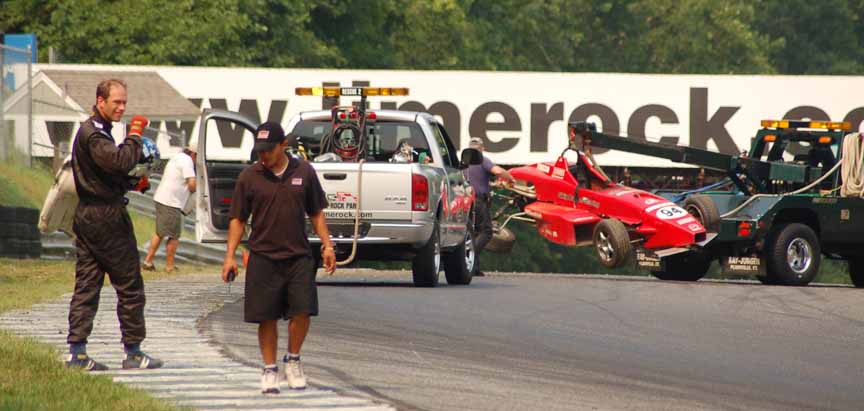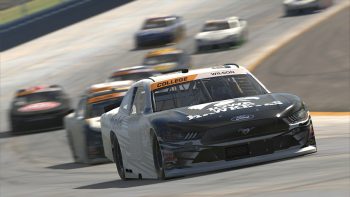
Safety Ratings—a cure for the mayhem in online racing games?
March 10th, 2010 by Dave Kaemmer
Back when sanctioned multiplayer online competition at iRacing was still just a plan brewing, we faced a difficult question:
How do we keep people from overdriving their virtual cars and wrecking everyone else (or at least minimize it), in order to make online racing more like real world on-track time?
Our answers to this question eventually resulted in the safety rating system that seems to generate a lot of heated debate. I thought it would be a good idea to explain the philosophy behind the system in more detail, including its historical roots. That way, there’s more fuel for the debate!
Online racing games, as much as we try to re-create the real-world experience, will probably always permit crashing that is safer, cheaper, and more convenient than in real racing. That’s why we do it! However, the lack of fear for personal safety, coupled with the instant repairs and miniscule repair bills, lends sim racing a well-deserved reputation for barely controlled mayhem. Taking that mayhem as a given, we needed to come up with some incentives at iRacing that would help produce cleaner, more realistic online races.
One of the many ideas we considered was to actually charge small amounts of money for “crash damage.” This would provide a parallel to real life racing, in that repairs are paid for by the car owner, no matter who is at fault. However, it could be argued that that would give iRacing an incentive to encourage more crashing, and we definitely don’t want that. We could address that concern by giving the money to charity, or providing it as prize money. The biggest downside, though, is that having to pay repair costs, no matter how small, would seriously escalate the bad feelings (i.e. testosterone-fueled anger) that inevitably result from just about any mishap on track. One good thing about crashing in real life is that you are so happy to be alive afterwards that you feel a lot less angry about it, even if it was somebody else’s fault. That’s not the case online, which is just another downside to the safety and convenience of simulated crashing. So we abandoned that idea. We have no need for more post-crash anger.
In the end, we implemented several things which, taken together, encourage driving in a safer manner. One is to require drivers to use their real names, in order to provide a little accountability and less anonymity to hide behind. Before you can race at a real track, you need to show your driver’s license, sign a release under your real name, and generally let other people know who you are. Keeping our reputations intact is a powerful incentive for (most of) us to behave ourselves.
Another way we try to improve overall safety is by starting new members as Rookies in less powerful cars, and have a racing license progression that allows them into faster, more difficult cars as they learn. In the real world, no-one steps into an Indy car on Day One of their driving career, and with good reason. It makes a lot of sense to work up to speed slowly, only moving to faster cars once you have mastered a slower one. How can we tell when someone has “mastered” a car? In the real world, the answer is when they have enough money for a faster one. That is only partly a joke! In fact, a driver who wrecks a lot of equipment is costing someone a lot of money, and that does tend to trip-up that driver’s career.
In iRacing, we decided that advancement to faster cars should be based only on drivers’ safety records, and not on how fast they are. In online racing, we need to emphasize safety over speed in order to minimize the on-track mayhem. In real life, the importance of safety is so obvious as to almost go unstated. It is just not considered good form to lose control of your race car, for any reason. “That idiot wrecked me!” only works a few times as an excuse before instructors and officials start raising their eyebrows and wondering if maybe there’s more than one idiot involved. Being fast is good, but being safe is better. It turns out that being safe is faster, too, in the long run. New drivers usually aren’t able to drive the car at the limit of the tires’ capabilities without taking a lot of risks—they reach their own limits as a driver before they reach the limits of the car, so they tend to think that faster = scarier, or, “to go faster I need to be more aggressive.” As drivers gain experience, they learn to control the car safely even beyond the limit, in the scary, but slower, sliding portion of the tire force curve. Once drivers are able to do that, then they are able to work on consistently keeping the car at the peak of the tires’ capabilities, while not coming anywhere close to the limits of their ability to control the car. So the fastest drivers aren’t fast because they are being more aggressive, they’re faster because they have learned more skills.

Unfortunately, it’s not possible to learn those skills without taking some risks. However, the best way to learn is to find a balance between pushing yourself to go faster, and keeping your aggression under control, so you don’t crash too often. The iRacing safety rating, or SR, system is designed to give you some clues about how well you’re doing at finding that balance. A simple rule of thumb is this: if your SR is in the 2’s or below, you need to work on controlling your aggression—take fewer chances, don’t fight so hard to gain (or maintain) a position, use patience, and concentrate on driving cleanly. If your SR is above 4, you are doing well at driving safely at your current license level—you could stand to push yourself a little harder to find some more speed. If your SR is in the 3’s, you’ve found a good balance.
You should generally find that if you work on staying out of trouble, you will have better finishes in races. If you find that other people are crashing you out all the time, you need to seriously think about whether you would drive the way you are driving if you were in a real car. In almost any incident involving two or more drivers, all the drivers share some responsibility—maybe not equal blame, but if you are even five percent at fault, you might have been able to avoid it. If you are truly zero percent at fault, you don’t need to worry too much, since those kinds of accidents are rare, and shouldn’t impact your SR in the long term.
How do we keep people from overdriving their virtual cars and wrecking everyone else (or at least minimize it), in order to make online racing more like real world on-track time?
Notice that at each license level, the expectation for safe driving is set a little higher. If you are a Class D, 4.5 SR driver and are promoted to Class C, your SR is reduced by one to 3.5. In other words, what’s a great level of safety for a Class D racer is only a good level for a Class C racer. As you move up the license ladder, you’ll need to stay focused on driving safely, but that should become easier as you gain experience. A lot of people watch their SR too closely—the hundredths digit doesn’t really matter (neither does the tenths, frankly), other than to give you an indication at the end of a session whether your driving during that session was considered safe (SR moves up), or not so safe (it moves down) for your license level. In the longer term, it will move to where it reflects your safety level, regardless of whether you’ve had a streak of bad luck or good luck. Then use the 2 (ease up), 3 (good work), 4 (go faster) rule of thumb. Of course, with the Fast Track promotions, you’ll be put right back at a 3, one license level up, unless you are a Class A driver. We hope the SR system is helping you to drive within yourself, and to have better races online!
















































